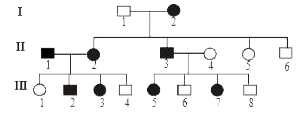If both parent are bald and their first female child is normal, then the chances of baldness in their second male child is :-
0.5
1
0.25
0
The correct Answer is:B
To solve the problem, we need to analyze the genetics of baldness in the given scenario. Here’s a step-by-step breakdown of the solution:
Step 1: Understand the Genetics of Baldness
Baldness is a trait that is dominant in males and recessive in females. This means:
- Males can be bald if they have at least one dominant allele (B).
- Females require two recessive alleles (bb) to be bald.
Step 2: Determine the Genotypes of the Parents
According to the question:
- Both parents are bald.
- The mother must have the genotype bb (homozygous recessive) since she is bald.
- The father can either be Bb (heterozygous) or BB (homozygous dominant) since he is bald.
Step 3: Analyze the First Female Child
The first female child is normal, which means she cannot have the genotype bb. The only possible genotype for her is Bb (heterozygous) since she must inherit one b allele from her mother and one B allele from her father.
Step 4: Determine the Father's Genotype
Since the first female child is Bb, the father must be Bb (heterozygous). If he were BB, all female children would be BB and thus bald.
Step 5: Set Up a Punnett Square
Now we can set up a Punnett square to determine the possible genotypes of their male children:
| | B | b |
|-----|-----|-----|
| b | Bb | bb |
| b | Bb | bb |
Step 6: Analyze the Punnett Square Results
From the Punnett square:
- 50% of the offspring (Bb) will be bald (since B is dominant in males).
- 50% of the offspring (bb) will not be bald.
Step 7: Determine the Chances for the Second Male Child
Since we are interested in the second male child, we look at the results:
- There is a 100% chance that a male child will be bald if he inherits the B allele (Bb).
- Therefore, the chances of baldness in their second male child is 1 (or 100%).
Conclusion
The chances of baldness in their second male child is 1.
---
Baldness is a trait that is dominant in males and recessive in females. This means:
- Males can be bald if they have at least one dominant allele (B).
- Females require two recessive alleles (bb) to be bald.
According to the question:
- Both parents are bald.
- The mother must have the genotype bb (homozygous recessive) since she is bald.
- The father can either be Bb (heterozygous) or BB (homozygous dominant) since he is bald.
The first female child is normal, which means she cannot have the genotype bb. The only possible genotype for her is Bb (heterozygous) since she must inherit one b allele from her mother and one B allele from her father.
Since the first female child is Bb, the father must be Bb (heterozygous). If he were BB, all female children would be BB and thus bald.
Now we can set up a Punnett square to determine the possible genotypes of their male children:
|-----|-----|-----|
| b | Bb | bb |
| b | Bb | bb |
From the Punnett square:
- 50% of the offspring (Bb) will be bald (since B is dominant in males).
- 50% of the offspring (bb) will not be bald.
Since we are interested in the second male child, we look at the results:
- There is a 100% chance that a male child will be bald if he inherits the B allele (Bb).
- Therefore, the chances of baldness in their second male child is 1 (or 100%).
The chances of baldness in their second male child is 1.
Topper's Solved these Questions
Similar Questions
The gametes of female determines the sex of a child in :
View SolutionOf both normal parents, the chance of a male child becoming colour blind are
View SolutionThe maleness of a child is determined by
View SolutionProbability of male child of haemophilic father and normal mother becoming haemophilic is
View SolutionIf male is impotent and female is normal then which of the following technique can be used ?
View SolutionIn this pedigree if III–2 married to a normal female, what will be the chances of first child being a diseased child ?

View SolutionFemales seldom become bald as they lack
View SolutionIf both parents are carriers for thalassemia, which is an autosomal recessive disorder, what are the chances of pregnant women resulting in an affected child?
View SolutionIf both the parents are carriers of autosomal r recessive disorder thalassemia , what are the chances of pregnancy resulting in an affected child
View SolutionA normal visioned man whose father was colour blind, marries a woman whose father was also colour blind .They have their first child as a daughter .What are the chances that this child would be colour blind ?
View Solution